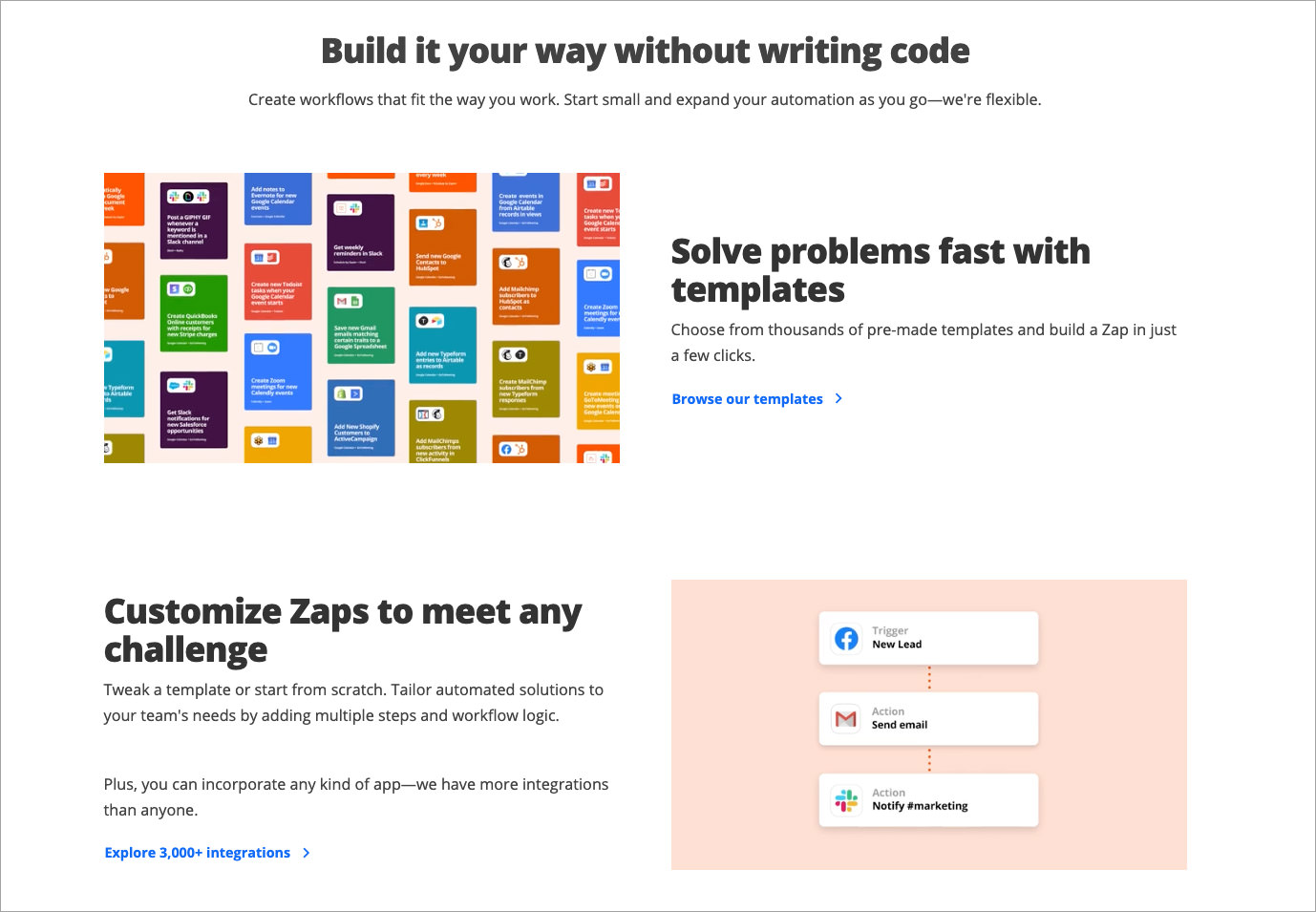
Connecting unrelated applications, making them work together, and automating several manual processes sounds like a lot of work for people, especially for those who have no coding knowledge. But thankfully, tools like Integromat and Zapier exist. These platforms enable users to connect applications easily with minimal coding involved and, in many cases, none at all.
This article is for decision makers who want to streamline and optimize their processes. If you’re here, most likely, you’ll benefit from either of these two.
.no-js #ref-block-post-52055 .ref-block__thumbnail { background-image: url(“https://assets.hongkiat.com/uploads/thumbs/250×160/zapier-zaps-and-recipes.jpg”); }
100+ Zapier Zaps and Recipes to Boost Productivity
Master automation with Zapier – explore over 100 Zaps and recipes for productivity. Read more
To give you a basic example of what you can do with both platforms… Imagine receiving email inquiries from potential clients. And for all of the emails that you get, you or your assistant have to copy their information to an external platform like Google Sheets or project management tools like ClickUp, Asana, etc..
Now, imagine if you receive hundreds to thousands of these emails monthly. If copying their information and saving it elsewhere takes an average of 1 minute each time, then you are looking at hundreds to thousands of minutes lost per month.
But with Integromat or Zapier, you can fully remove the human in this process. It can simply go from email straight to your CRM or project management tool – without human intervention.
What are the key differences between the two?
Price Differences: Integromat vs. Zapier
Before we delve deeper into the key differences between the two automation platforms, we should first take a look at their pricing because it will shape a lot of your decision-making.
At a glance at the table below, Zapier seems like it’s the more expensive choice. Integromat’s Free plan has 1,000 operations/month, while Zapier’s free plan only has 100 free tasks/month. Remember, tasks and operations have practically the same meaning here, just different terminologies used. Then, when you look at the Starter plan of Zapier, it’s only at 750 tasks per month, while Integromat’s Free plan is still ahead by 250 tasks or operations.
To take things a bit further, Integromat’s most expensive plan is only $299/month at 800,000 operations/month, while Zapier’s is at $599 at only 100,000 tasks/month.
Should that dissuade you from choosing Zapier? Not quite.
Zapier


- $0 – Free with 100 tasks/month.
- $19.99 – Starter plan with 750 tasks/month.
- $49.00 – Professional plan with 2,000 tasks/month.
- $299.00 – Team plan with 50,000 tasks/month.
- $599 – Company plan with 100,000 tasks/month.
See Zapier’s Pricing Plans plus all features included.
Integromat
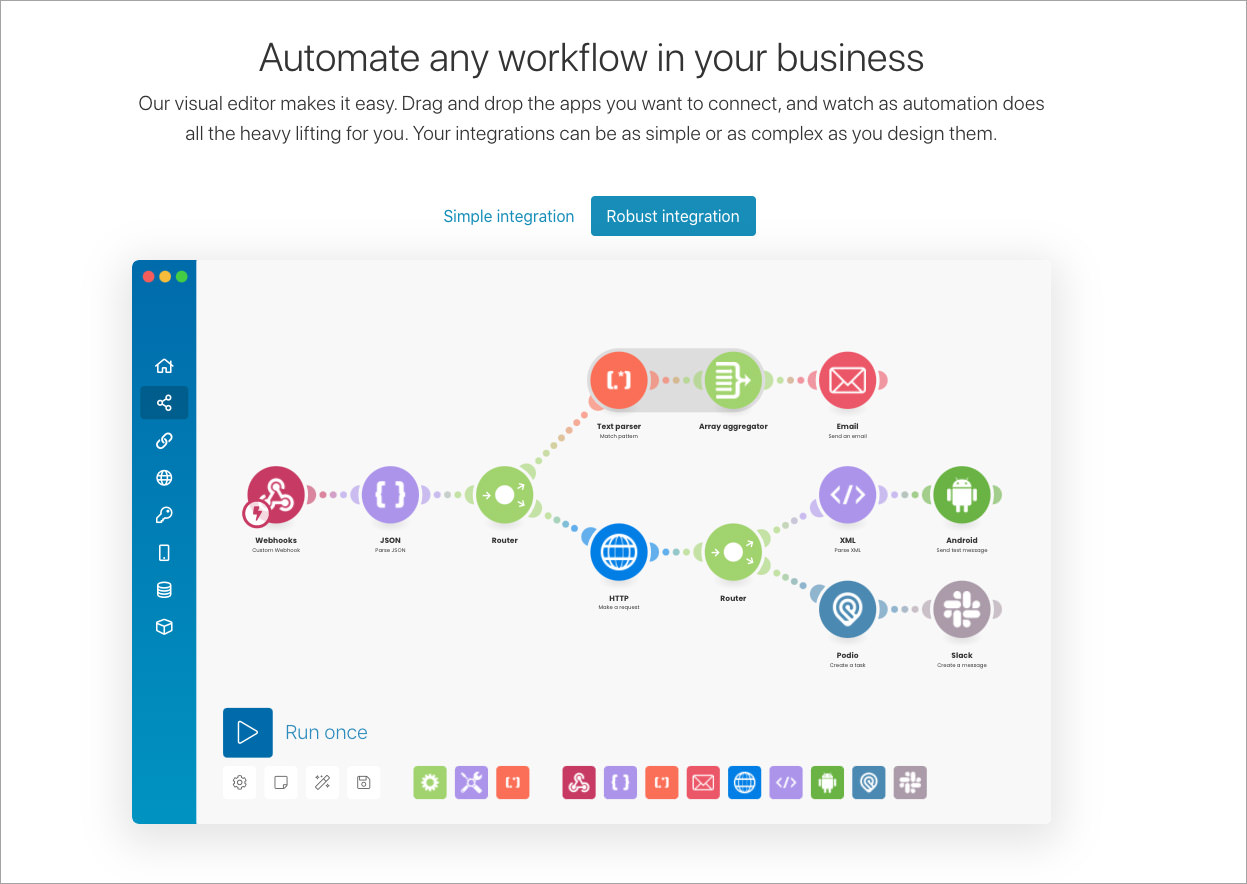

- $0 – Free with 1,000 operations/month.
- $9 – Basic with 10,000 operations/month.
- $29 – Standard with 40,000 operations/month.
- $99 – Business with 150,000 operations/month.
- $299 – Platinum plan with 800,000 operations/month.
- Custom plan is available if you need more than 800,000 operations/month and 220+ GB data transfer.
See Integromat’s Pricing Plans and features.
As you can see, there’s a huge difference between the two regarding pricing. But this shouldn’t be the only criterion. Depending on your needs and skill set, you’ll probably want one over the other.
Let’s dissect them below.
Custom Coding
Zapier wins over Integromat in terms of running scripts. If you would like to use Python or JavaScript to execute codes, then using Zapier is a clear choice since it has built-in support. Integromat doesn’t have this yet, although people have requested it for a couple of years now.
One workaround for Integromat is by using Google Cloud Functions to execute Python scripts.
Editing Steps
One thing I don’t like about Zapier is that if you have 10 steps in a Zap, and if you’d like to remove or change the 5th step, there is no way to just remove or change that step as it is. You have to remove everything before it.
Meanwhile, with Integromat, you can easily change any module/step wherever they are and just adjust the data accordingly.
Complexity
In terms of the complexity of the automation you can build, Integromat clearly is the winner. Although a huge limiting factor is running scripts, you can still build a really complex workflow if you don’t need that.
For example, with Zapier you can build conditional pathways called Paths. If X is equal to 1, then use Path A. If X is equal to 2, then use Path B. Right now, it’s only limited to 5 Paths.
This limitation does not exist on Integromat. You can literally create dozens upon dozens of different paths or conditions.
If that’s not clear enough, let me give you an example.
Suppose you want to automatically sort leads based on your questionnaire with the following fields:
- City – Osaka, New York, London, Rome, Manila, Brasilia.
- Gender – Male, Female.
- Education Level – High School, Bachelor, Master, PhD.
- Plan – Plan A, Plan B, Plan C.
With the fields and possible answers above, if you are using Zapier and if your main sorting key is City, you can only have 5 main sorting Paths. And inside those sorting paths is another set of 5 Paths you can use. So in this case, it will look like this:
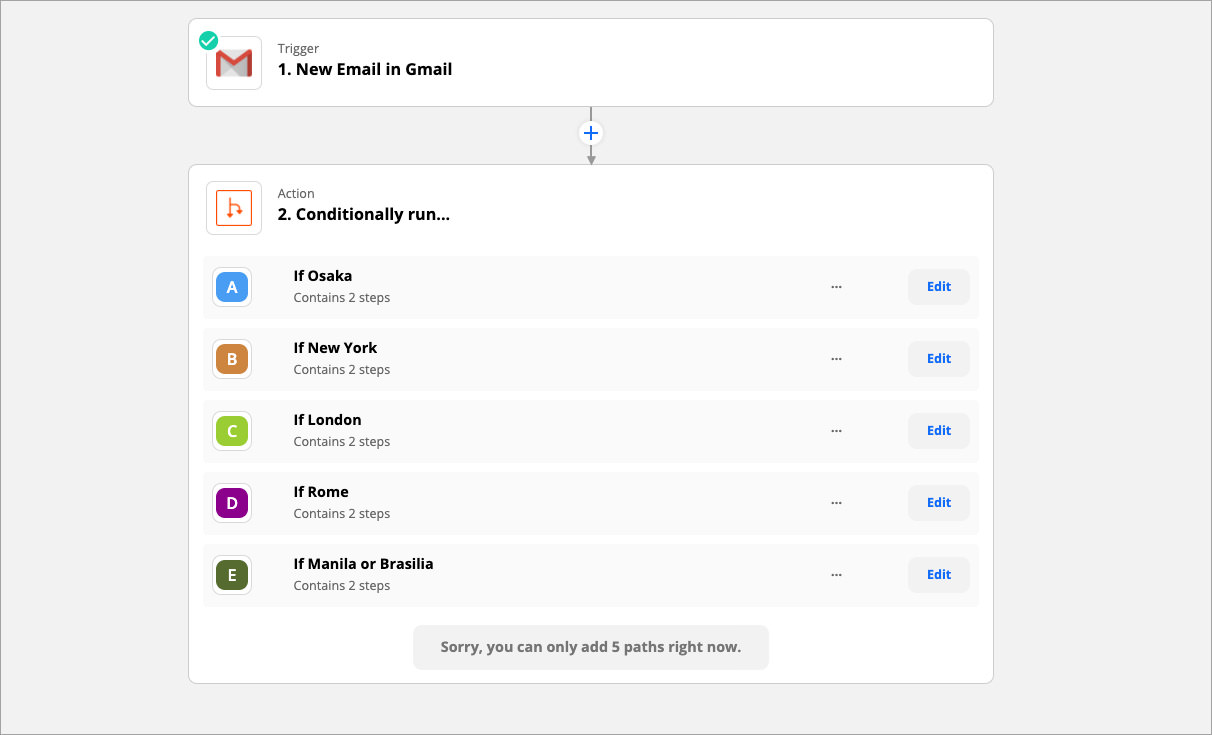

So there’s no more Path left for Brasilia. In this case, a workaround is to use Path E this way:
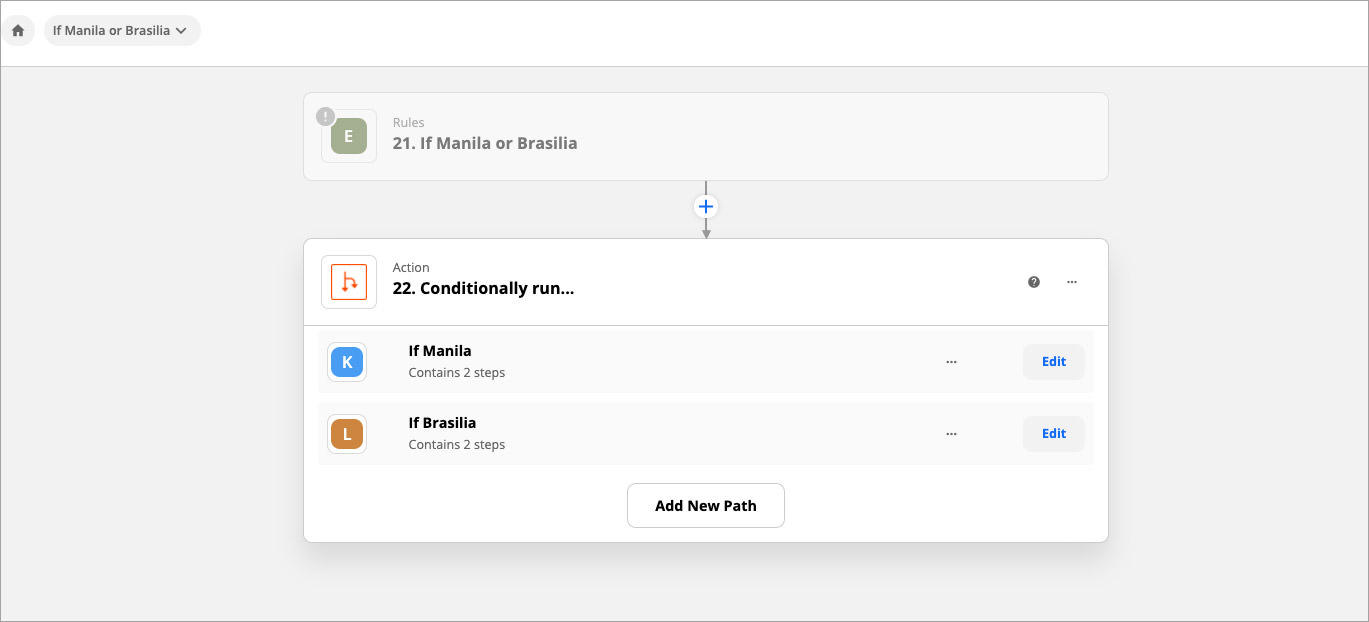

But if you do it on Integromat, it will look like this:
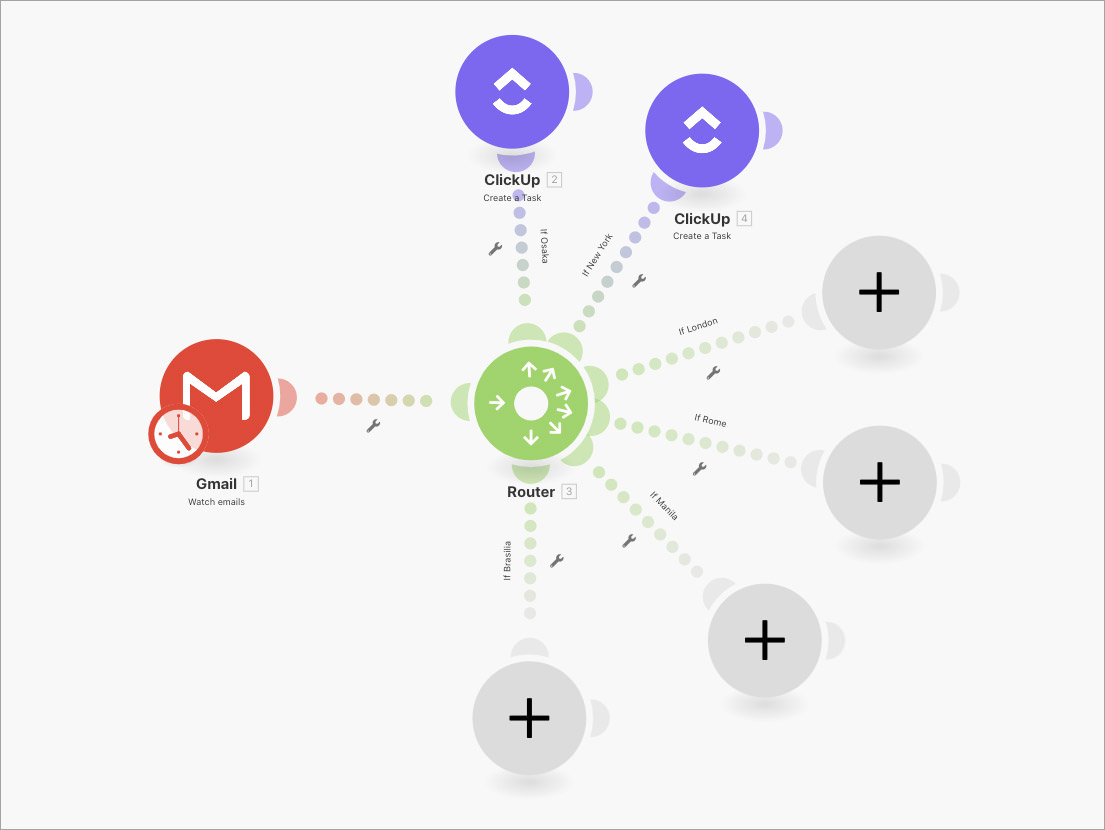

As you can see, you can create more than five different paths with different filters each. And in the example above, it’s just 6, but you can add a lot…honestly, I stopped adding more after 30.
So, that said, can you imagine the possibilities you can do with this much freedom?
Third-party Integration
I am torn between Zapier and Integromat when it comes to the available integrations and what options there are for the available modules.
For example, using ClickUp, on Zapier you can create a Space via a Template, but if you use Integromat, that option is not available.
I can list a couple of applications available in both that aren’t in the other but that will take time. But the great thing is, you can actually use webhooks or connect directly to the application’s API. You’re probably not in luck if the application you want to connect to doesn’t have a public API to connect to, though.
So before choosing between Zapier and Integromat, make sure to check if they have an API, Webhooks, or at least if they are available on Zapier and/or Integromat.
Uptime
In the past 30 days as of writing this, Zapier had a perfect score of 100% uptime, meanwhile Integromat had an outage for about 60 minutes before it was resolved. So, in terms of reliability, I would have to give the points to Zapier.
- See Integormat’s Uptime
- See Zapier’s Uptime
Customer Service
Based on my experience for both, they usually have a response time of less than 24 hours. However, I must admit that I’m a fan of Zapier’s customer service especially when it comes to scenarios that I am having trouble with.
For example, if I simply can’t find the possible logic to do something, Zapier’s customer service will usually reply with the actual solution and even recommend some more. Meanwhile, my experience with Integromat is like that too, but not as detailed with Zapier.
Pros, Cons, and Final Thoughts
Zapier Pros
- Replaying a task is possible, and Zapier also generates sample data so you don’t have to manually trigger it each time while building or debugging.
- Over 3,000 applications ready for integration.
- Has a solid support team.
- Uptime is near spotless.
Zapier Cons
- The way you edit your steps or modules isn’t exactly friendly.
- When compared to Integromat, Zapier is expensive.
- You can’t change the trigger or any other steps without deleting the previous steps. I hate this about Zapier and it’s what keeps me from giving it a 5/5.
Integromat Pros
- Affordable plans.
- Has a Data Store feature where you can natively store information so you can pull it again in the future. No need to save data outside for reprocessing at a later time.
- If you know how to use their Error handling features, you can mitigate problems such as when there are downtimes between your apps (not just Integromat).
- You can build extensive systems within Integromat.
- You can easily edit modules no matter where they are unlike Zapier.
Integromat Cons
- Replaying a task is not possible, and each time you have to send a sample data, you’ll have to actually send it unlike Zapier.
- Compared to Zapier, Integromat only has 650+ apps ready for integration.
- Does not natively support code execution.
- Has issues with uptime.
- Searching the logs is not possible, so if you are debugging a workflow, be prepared to wade through hundreds to thousands of logs.
As you can probably imagine, both Zapier and Integromat have their own pros and cons that can either make or break the deal, so I cannot exactly recommend one over the other until I know what your needs are. They are great tools that I use almost daily for different clients in setting up and optimizing systems, so I can’t tell you which is my favorite — I use both of them equally.
But to give you an idea, if the workflow you are building is task-intensive and you are on a limited budget, then Integromat is the way to go. But if you have the budget for it and the apps you need to integrate aren’t on Integromat, then go with Zapier.
The post Integromat vs. Zapier: Features, Prices, Pros & Cons (2023) appeared first on Hongkiat.